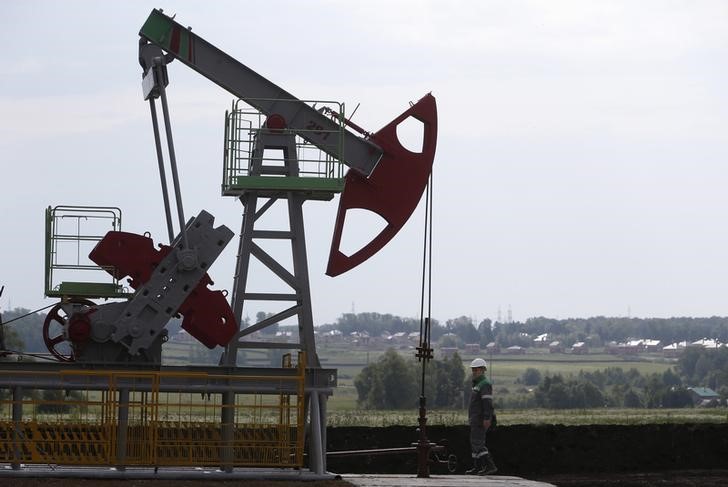(John Kemp is a Reuters market analyst. The views expressed are
his own)
By John Kemp
LONDON, Aug 13 (Reuters) - U.S. shale oil production
amounted to just 5 million barrels per day (bpd) at the end of
2014, less than 6 percent of world production and consumption.
Despite the shale sector's small market share, it has
disrupted the entire oil industry because it emerged in the
middle of the cost curve and has accounted for more than half of
the increase in global supplies since 2010.
Between 2010 and 2014, shale output rose by 4 million bpd,
accounting for more than half of the 7 million bpd increase in
global liquids production over the same period, according to the
U.S. Energy Information Administration (EIA).
Shale is more expensive to produce than oil from the giant
conventional fields of the Middle East but cheaper than
deepwater megaprojects and competes directly against the North
Sea and Canada's oil sands.
Shale's competitiveness on price and fast growth have
scrambled the plans for every other participant in the oil
industry.
Megaprojects developed by the major international companies
must now be benchmarked at prices of just $70 or even $50 a
barrel rather than the $80-$100 which underpinned planning
assumptions until a year ago.
Middle East exporters, accustomed to spending profits of
more than $50 per barrel on social programmes, must now adjust
to far smaller revenues.
And high-cost producers in the North Sea, Alberta, Latin
America, Africa and frontier exploration areas are struggling
just to survive.
Experts originally put the marginal cost of oil from the
shale plays in North Dakota and Texas at $70 per barrel but
efficiency gains have cut breakeven prices to $60 or even $50
and they could be as low as $40 or even $30 in the best areas.
Shale can justifiably be called a revolution comparable to
the introduction of rotary drilling at the turn of the 20th
century and the opening of huge conventional reservoirs in the
Middle East in the 1950s and 1960s.
But shale's disruptive impact should not obscure the fact it
still meets only one-twentieth of global oil demand.
Too much analysis still focuses exclusively on shale and
OPEC, ignoring the effect of lower prices on non-OPEC non-shale
output, which accounts for more than half of global liquids
production.
The market has become obsessed with breakeven rates for the
very best parts of the Bakken, Eagle Ford and Permian Basin
shale plays, as if those were all that mattered for the price of
oil in the short and medium term.
But the medium-term outlook for the oil market depends on
continued growth in conventional production and applying the
techniques pioneered in North Dakota and Texas to other plays in
the United States and to countries such as Argentina, Russia and
China, where costs are much higher.
SHALE BREAKEVENS
According to most forecasters, global oil demand is growing
at an annual rate of 1.5 million bpd or more, which must be met
from somewhere.
U.S. oil production has held up surprisingly well in the
face of a slump in prices, but is set to be lower at the end of
both 2015 and 2016 than at the end of 2014, according to the EIA
("Short-Term Energy Outlook", August 2015).
After three years in which U.S. production grew on average
by more than 1 million bpd annually, U.S. output is expected to
expand by just 650,000 bpd on average in 2015 and then shrink by
400,000 bpd in 2016.
With shale stalling, increased demand will have to be met by
OPEC and non-OPEC non-shale producers.
Saudi Arabia and its close allies in the Organization of the
Petroleum Exporting Countries are banking on this to rebalance
the oil market and absorb an increase in Iran's exports in 2016.
Saudi strategy is not as far-fetched as it may seem.
While shale producers may be able to cope with prices of $40
or $50 per barrel by high-grading and focusing on the best areas
of existing plays, the industry will struggle to grow much
unless prices rise.
Breakevens in the core counties of the Bakken might be as
low as $30 or $40, according to North Dakota state regulators,
but outlying areas need $60 or more to cover their costs and
provide acceptable returns.
The same is true for the Eagle Ford, Permian Basin and
Niobrara shales in Texas and the southwest: it may be possible
to sustain production by retrenching to the core but substantial
growth will likely require higher prices to enable more marginal
areas to be developed.
NON-OPEC, NON-SHALE
Outside the United States and OPEC, sustaining and growing
production requires substantial investment to offset decline
rates from existing wells and add extra output.
But non-OPEC producers are slashing capital expenditure.
With oil prices hitting new lows, non-OPEC non-shale producers
have embarked on another round of layoffs and cost-cutting.
The number of rigs drilling for oil outside North America
and OPEC has fallen by 22 percent since July 2014, according to
oilfield services company Baker Hughes (NYSE:BHI).
Further reductions in the rig count seem inevitable in
coming months as existing drilling programmes are completed and
exploration and production budgets pared back.
Many analysts still assume either OPEC or the shale
producers will have to cut production substantially to realign
the market.
It is more likely OPEC production will continue to grow,
shale stabilises or shrinks slightly, and the rest of the
adjustment is borne by a substantial slowdown in conventional
non-OPEC output, coupled with continued growth in demand.
(Editing by Dale Hudson)
